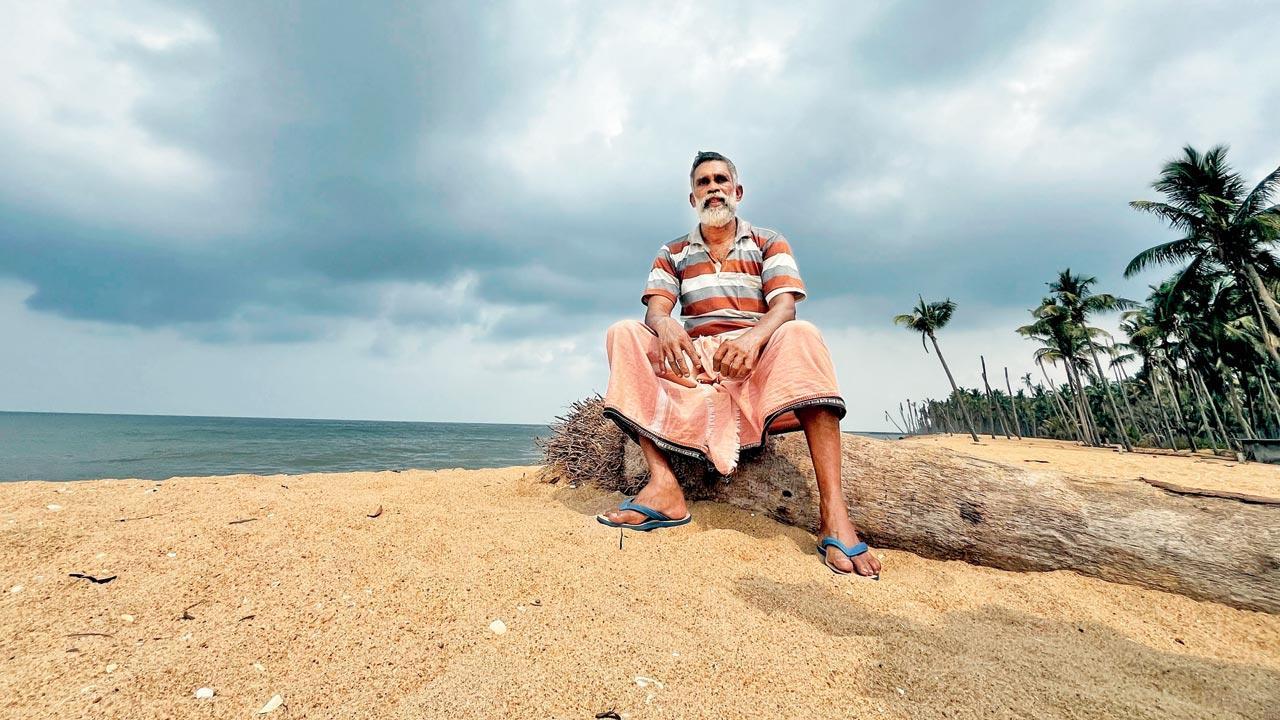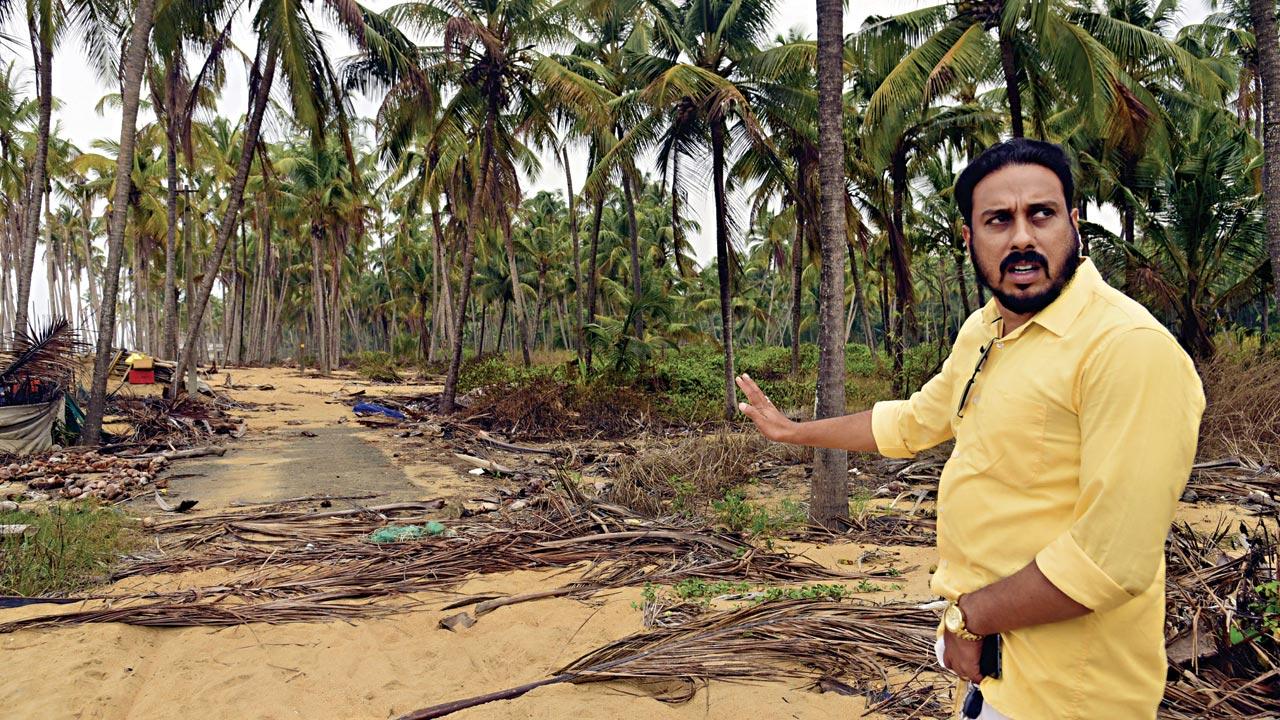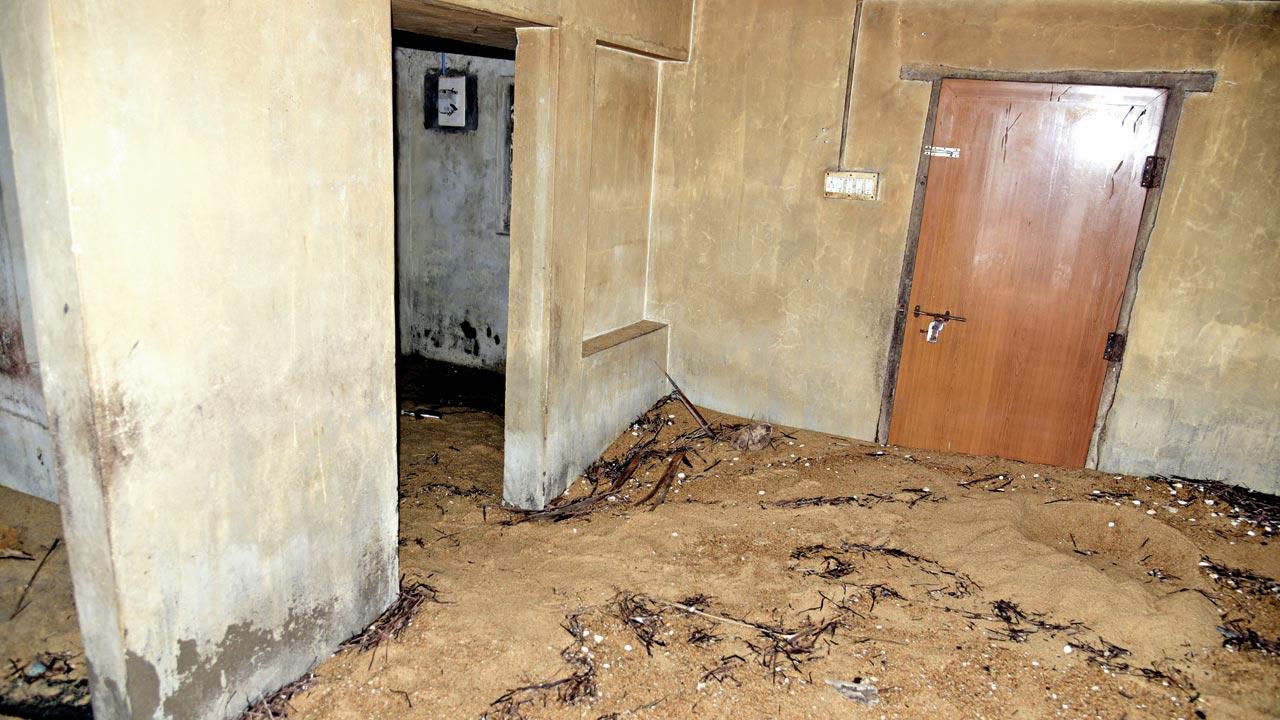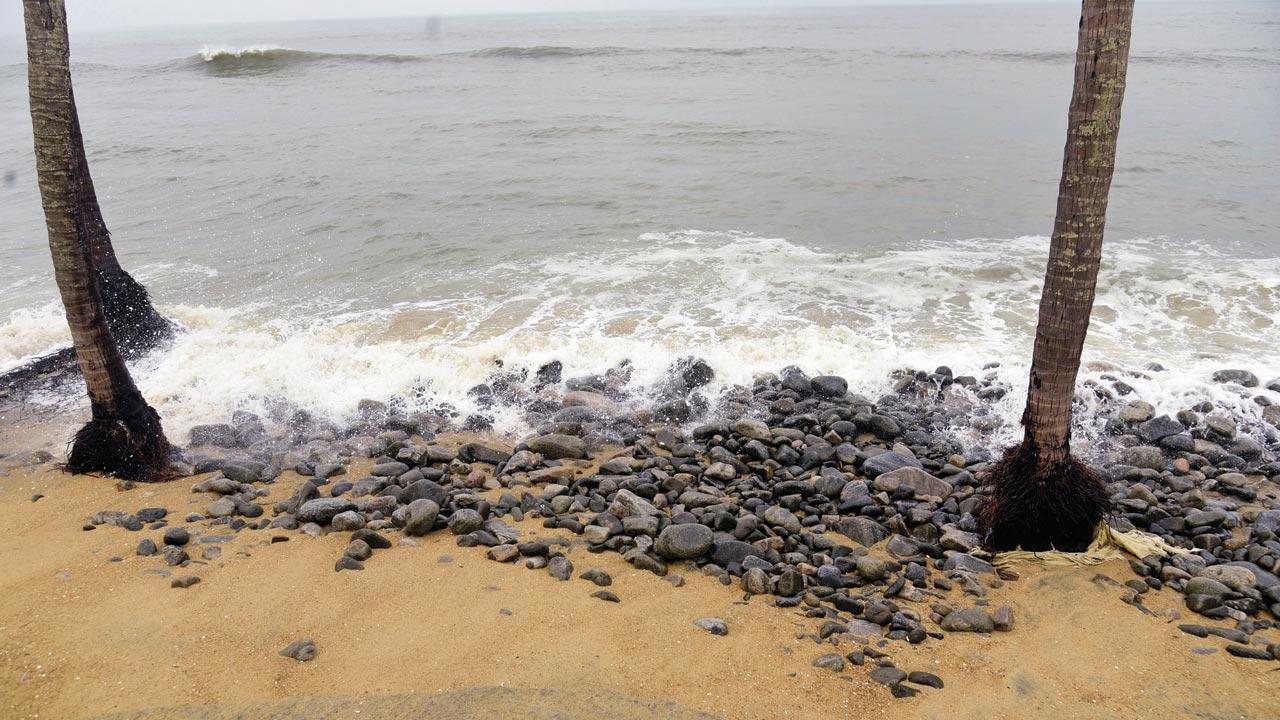The sea has been taking large bites of Kerala’s coasts, swallowing houses, farms, and livelihood. The vote, in these parts, will go to the candidate who will compensate this loss

Every morning, 62-year-old Vivekanandan sits on the shore near Kadappuram village, which is largely comprised of fisher folk, to look out at the sea which gulped down the house where he was born. He has not received any compensation for his losses, till date. Pics/Atul Kamble
Every morning, 62-year-old Vivekanandan sits on the shore near Kadappuram village and looks out at the sea where his house would have stood. He was born in it, and with his meagre earning as a daily-wage labourer, converted into a pukka house, with terrace. He lived in it for more than six decades until the sea pushed him out one night, giving him and his family just enough time to gather valuables and run.
ADVERTISEMENT
To his neighbours, mostly fisherfolk, his loss is not unique, or more tragic than theirs. On the coastal belt of Engandiyur in Thrissur district, Kerala, the sea has been chipping land away for years. By gnawing away at natural barriers such as beaches and sand dunes, coastal erosion can increase vulnerability to storm surges, cyclones, and tsunamis. The extensive coastal erosion plays a role in altering surface temperature, resulting in global warming.
The village, a settlement of nearly 100 years, is just short of a ghost town. A handful of villagers, whose homes are at a higher altitude, hang bravely on in the face of the steadily advancing sea. The rest have moved away after losing homes, and after farmland and the last of their coconut trees were poisoned by the salt spray, which has shunted their growth and most have died.
 Shijil Chulliparambil points at a submerged tar road, through which vehicles used to enter the village. The pipeline connection set up to provide drinking water for the villagers was weak and hence, the government provided water through tankers to the island free of charge. However, after sand filled up the main tar road after the flood, water tankers are now unable to enter the village
Shijil Chulliparambil points at a submerged tar road, through which vehicles used to enter the village. The pipeline connection set up to provide drinking water for the villagers was weak and hence, the government provided water through tankers to the island free of charge. However, after sand filled up the main tar road after the flood, water tankers are now unable to enter the village
Vivekanandan’s family has been custodians of this land for more than two generations. On dark night approximately three years ago, the sea pushed past the two-km stone wall that tried to hold it back, and took over the village.
“The fear of the sea flooding us would keep us awake during torrential downpour,” he says. “Soon the day arrived when the sea reached the compound of my house. It was 2 am. My 950 sqmt terraced home—with three bedrooms and a kitchen—stood on 30 cents of land inherited from my father. (One cent is 40.46 square metre; 100 cents make one acre. The measurement is used in south India).” The house cost six to seven lakhs, and the family lived in it for 15 years. “As the sea water entered our home, my family took what we could and rushed out. As my house crashed, it took with it all my hopes of living securely till my death.” Even the 2004 tsunami had left the village alone. With no money to build a new house or buy one, Vivekanandan lives on rent.
He has moved both state and district administration for compensation. “I had met Chief Minister Prinarayi Vijayan, who directed my file to the district collector (Thrissur), who sent the file back to the CM’s office with his notes.” Nothing further was done.
 Silt and sand have made homes close to the shore unfit for humans to reside
Silt and sand have made homes close to the shore unfit for humans to reside
Kadappuram island is sandwiched between the National Highway on the East, and the Arabian Sea on the West, about 250 metres away from both. Shijil Chuliparambil remembers it being abundantly green up until three years ago.
Then the sea creeped 100-200 meters inland and the salinity destroyed farms and vegetation. About 30 to 40 coconut trees populating a five-cent plot stand bare and dying from the constant spray of salt water.
A tar road ran through the village, on which came water tankers sent by the government to supplement the weak pipeline connection for drinking water. Now, it lies buried under sand.
Cut off from potable water, with no transportation and dying farms, families have been forced out of their homes.
 Not just vegetation, but people’s homes and means of livelihood have been destroyed. Pointing to the bare village bordering the sea, Chuliparambil says there were nearly 30-40 coconut trees on a five-cent plot of land, but now those coconut trees are bare
Not just vegetation, but people’s homes and means of livelihood have been destroyed. Pointing to the bare village bordering the sea, Chuliparambil says there were nearly 30-40 coconut trees on a five-cent plot of land, but now those coconut trees are bare
Two women remain in a house that looks like it would keel off into the sea during high tide. Land ownership disagreement keeps them put. The remedy is a stone wall to reinforce the borders of the village. To help fishing boats navigate, T Prathapan, the sitting CPI MP, built a groyne (called pulimuttu in Malayalam). The low wall goes into the sea from the beach to prevent soil erosion and drifting. But the groyne was a disaster, says Chulipramabil.
“Due to the groyne, the sea water came into the island with great force,” says Chuliparambil. “At high tide, the sea water will lash 200 metres into the village. Villagers would move in with their relatives temporarily. “In two years, the island will submerge,” warns Chuliparambil.
“I’m a stone mason,” Vivekanandan recalls, “and whenever the stones on the groyne broke or were swept away, I would be called to rebuild those portions. It became difficult to get stones and the wall collapsed. When I was growing up, the sea did not rise so high.”
“When we realised the groyne caused the sea to swell, it was broken down, and ida-pulimuttu or in-between groynes were built. They have not provided any relief to the fisherfolk,” says Chuliparambil.
Meanwhile, no one is building homes in Kadappuram, and there are no businesses. A family, seeing the potential in a seaside retreat, had built a large house at the cost of Rs 20-25 lakh a few years ago. Just as it was ready to open its doors to tourists, the sea rose and swallowed it. The family lost their life savings, recounts Chuliparambil.
The village, as it were, is still inhabited only in some places on higher ground. In June, when the monsoons come to Kerala, some residents will move inland into the homes of relatives. When they return, if their dwellings remain, they get to cleaning out the silt and sand left behind.
Fishing families in Kerala have struggled with the effects of coastal erosion for years, with many forced to take refuge in relief camps after their houses are destroyed.
Shashi Tharoor, sitting MP from Thiruvananthapuram had told MidDay earlier that, “For a dozen years, I have been bringing to the attention of Parliament, the ministers and the Prime Minister that we have lost 64 sq km of our Bharat Mata’s Bhoomi from our beaches, in this constituency alone.
“Had that much land been taken by a foreign country, the whole nation would be prepared to go to war, but when it is taken by the sea, there is absolutely no willingness to spend any money to do the elementary things required to save coastlines such as building seawalls and groynes. Something Tamil Nadu has successfully done. But here the state government claims that it has no money and the Central government says it is not its problem; shoreline protection is the responsibility of the state.”
T Prathapan, the sitting MP, has not done much in this area, says Chuliparambil. Now hope is pinned on BJP candidate Suresh Gopi. Both he and Prime Minister Modi have assured development in Thrissur. “We will present a memorandum to whoever is elected next, and hope urgent measures are taken,” he said.
Dr Jiyalal Jaiswar, former chief scientist at CSIR-National Institute of Oceanography in Mumbai, holds that mangroves could save coastal Kerala.
“Coastal erosion there is mainly due to strong winds, tidal currents, and tidal waves,” he says. “These are also influenced by changes to natural topography by construction of harbours, ports, and dams. Sand and coastal mining are also influencing factors. Most coastal regions around the world are precariously positioned due to climate change and intrusive human development. West Bengal is most vulnerable in terms of coastal erosion, and Kerala comes next as per available data.”
His remedy is plantations of mangroves in intertidal areas. Geotube seawalls can be successful in small beaches, where waves are not too strong. “Protecting sandy shores is essential to check coastal erosion,” Dr Jaiswar adds. “Submerged aquatic vegetation, organic sand fencing, and artificial reefs made using bamboo fencing have been effective in other countries.” Prohibition of dredging and sand removal is also crucial.
In some countries, appropriate versions of seawalls—Curved face (to accommodate the impact and run-up of large waves); Stepped face (to limit wave run-up and overlapping), Rubble (rough surfaced to absorb and dissipate wave energy)—have helped. Some parts of the Gulf of Khambhat have been bolstered by sand bags, says Dr Jaiswar, but this can be applied only to limited areas.
Meanwhile, Vivekanandan goes every day to gaze out at where his beloved house once stood. After a couple of hours, he trots back home. “Most days,” he says, I try not to remember the sight of my house getting washed away. My health is not good these days, and I work when I can. If I recall my old concrete home, I’m unable to sleep. My wife and children try to comfort me saying, ‘What can be done now?”
Vivekanandan passed away due to a cardiac arrest before this article would go to press. Chuliparambil said, “He was broken since he lost his house. And he never got compensated. All that took a toll on him.”
 Subscribe today by clicking the link and stay updated with the latest news!" Click here!
Subscribe today by clicking the link and stay updated with the latest news!" Click here!







